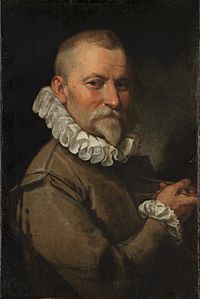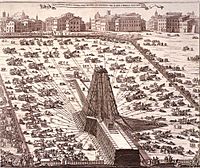Domenico Fontana facts for kids
Domenico Fontana (1543 – 1607) was a famous Italian architect. He lived during the late Renaissance period. He was born in a place called Ticino, which is now part of Switzerland. Domenico Fontana mostly worked in Italy, especially in the cities of Rome and Naples.
Contents
Early Life and Career
Domenico Fontana was born in Melide. This village is located on the beautiful Lake Lugano. At that time, Melide was shared by several Swiss regions. He later died in Naples.
In 1563, Domenico moved to Rome to join his older brother. He started his career working with plaster. Then, he became a skilled mason and master builder. He was very good at measuring and had strong technical skills.
Designing for Pope Sixtus V
Fontana's first big project was a villa in Rome. He built it for Cardinal Montalto between 1577 and 1578. The cardinal later became Pope Sixtus V.
In 1584, Pope Sixtus V asked Fontana to build the Cappella del Presepio. This chapel is inside the Basilica di Santa Maria Maggiore. It is a strong building with a dome. The chapel has many beautiful details and rich decorations. But these decorations do not take away from the main design.
For the same Pope, Fontana also built the Palazzo Montalto. This palace is near Santa Maria Maggiore. Fontana was very clever in how he planned the building. He made sure it fit well into the space available.
After becoming Pope, Sixtus V made Fontana the main architect of St. Peter's. He also gave him the special title of Knight of the Golden Spur. Fontana added the top part, called the lantern, to St. Peter's dome. He also suggested making the inside of the church longer.
Key Architectural Projects
Fontana made important changes to the Basilica di San Giovanni in Laterano around 1586. He added a large double archway to the front of the building. He also likely added the two-story entrance to the Scala Santa. Fontana loved using archways in his designs.
He used this style in fountains he designed with his brother Giovanni. Examples include the Fontana dell'Acqua Paola and the Fontana di Termini. In 1585, he became a member of the Accademia di San Luca, a famous art academy.
Among his other buildings, the Lateran Palace shows his strong style. He started building it in 1586. Fontana was very good at using sound building principles. However, he often used the same design ideas. For example, he used the design of the Lateran Palace again for parts of the Vatican. He also used it for additions to the Quirinal Palace.
Fontana also designed the connecting parts of the Vatican's courtyards.
Moving Ancient Obelisks
One of Fontana's most amazing achievements was moving ancient Egyptian obelisks. In 1586, he moved a 327-ton obelisk to St. Peter's Square. This huge engineering task needed 900 men, 75 horses, and many ropes and pulleys.
Fontana wrote a detailed book about this project. It was called Della transportatione dell'obelisco Vaticano e delle fabriche di Sisto V (Rome, 1590). The famous astronomer Ignazio Danti helped him with this work.
Fontana also used his knowledge of statics (the study of how forces affect objects) to move three other ancient obelisks. These were placed in the Piazza del Popolo, Piazza di S. Maria Maggiore, and Piazza di S. Giovanni in Laterano. People were very amazed by his skills.
Later Years and Legacy
-
Ceiling design for Sale Sistine - Vatican Library
After Pope Sixtus V died, Fontana continued working for the next Pope, Pope Clement VIII. However, people soon became unhappy with his style. Some also accused him of misusing public money. Because of this, he was removed from his job.
Fontana then moved to Naples. There, he became the architect for the Viceroy, the count of Miranda. While working in Naples, a team building a canal for him found the ancient city of Pompeii. Besides designing canals, he also built the Palazzo Reale in Naples.
Domenico Fontana died in 1607. He was buried in the church of Sant'Anna dei Lombardi.
Domenico's brother, Giovanni Fontana, was also an architect. Domenico's son, Giulio Cesare, took over his role as Royal Architect in Naples.
See also
 In Spanish: Domenico Fontana para niños
In Spanish: Domenico Fontana para niños
Works
- Domenico Fontana. Della transportatione dell'obelisco Vaticano e delle fabriche di Sisto V. Rome 1590.
- Online edition, from New York Public Library.
- Online edition, from Rare Book Room.







